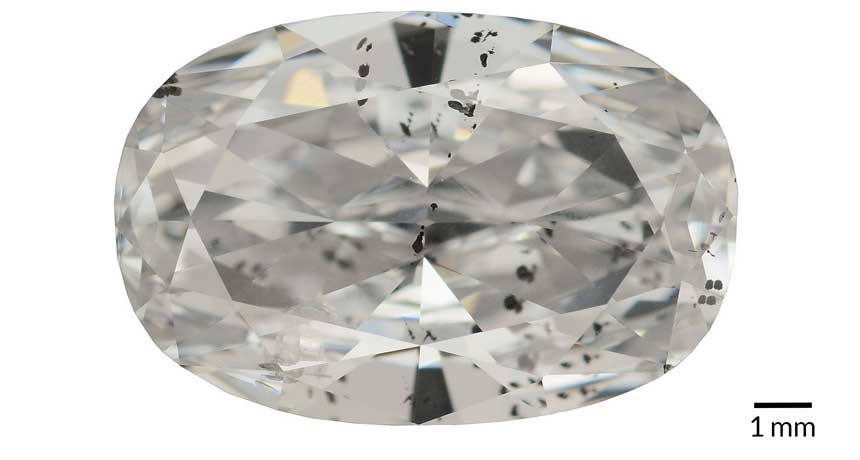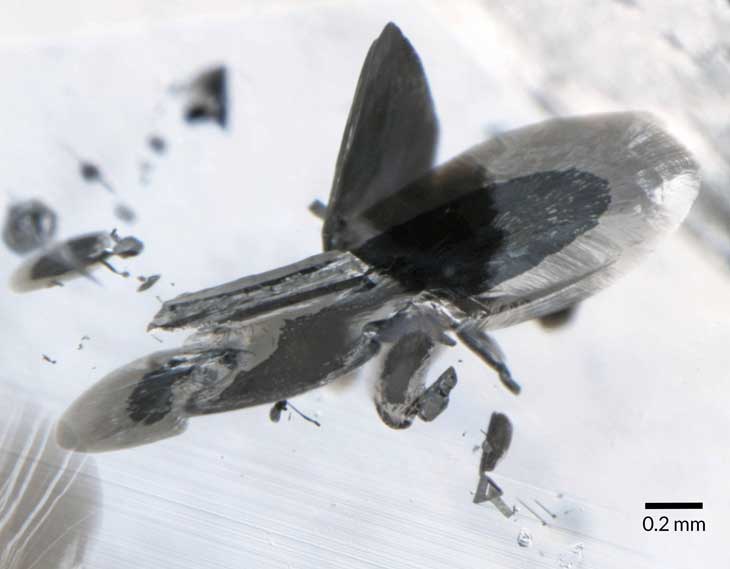Megadiamonds point to metal in mantle
Glimpse of deep Earth chemistry found in rare gems’ imperfections

DEEP DIVE Metal shards (black spots) in this diamond hold clues to the deep-Earth environment in which it formed.
Jae Liao
- More than 2 years ago
Imperfections in supersized diamonds are a bummer for gem cutters but a boon for geologists. Tiny metal shards embedded inside Earth’s biggest diamonds provide direct evidence that the planet’s rocky mantle contains metallic iron and nickel, scientists report in the Dec. 16 Science.
The presence of metal in the mantle is “something that’s been predicted in theory and experiments for a number of years, but this is the first time that we have samples that give us physical evidence,” says Evan Smith, a geologist at the Gemological Institute of America in New York City who led the study.
Understanding the composition of the mantle can help scientists figure out how it drives plate tectonics, and how elements like carbon and oxygen are cycled and stored in the Earth.
Diamonds form in the mantle when carbon-containing compounds are compressed and heated to great temperatures (SN: 4/30/16, p. 8). During this process, traces of other elements can sneak in as “inclusions.” Inclusions make the mineral less valuable as a gemstone, and chunks with many such imperfections are often rejected by jewelers. But to scientists, such stowaways are priceless: They provide some of the only physical evidence available of what’s going on deep inside Earth.
Story continues below image.

Smith and his colleagues used lasers to identify inclusions in samples from some of Earth’s largest diamonds. Some diamonds like these were originally hundreds or even thousands of carats. The Cullinan Diamond, for instance, was as big as two stacked decks of cards and weighed 621 grams, or more than a pound.
By analyzing the inclusions in 53 diamond samples, Smith’s team found that the megadiamonds formed much deeper than ordinary diamonds — hundreds of kilometers down, in a different part of the mantle.
“Not only are [these diamonds] very large and very valuable, but they appear to be very special in terms of their origin,” says Graham Pearson, a geochemist at the University of Alberta in Canada who wasn’t part of the study. Other minerals brought up from such a depth don’t preserve chemical clues to their environment in the same way.
In the deep diamonds, Smith found inclusions made of a mixture of solidified iron, nickel, carbon and sulfur, surrounded by a thin skin of methane and hydrogen.
Aside from the molten metal core, most iron inside Earth is thought to be incorporated into other minerals, not as a stand-alone metal, says Pearson.
But the metallic inclusions suggest that the part of the mantle where the large diamonds formed contains iron and nickel as metals. And the fact that the metals hadn’t reacted with other elements to form compounds suggests that the diamonds’ birthplace probably contains very little oxygen.
Smith thinks the metallic mixture was probably molten at the time the diamonds were forming. Instead of being sprinkled throughout like grated parmesan on spaghetti, ribbons of iron and nickel might have rippled through the mantle like gooey cheddar-jack through mac-and-cheese.
“You need very special conditions to get a metallic melt,” says Catherine McCammon, a geologist at the University of Bayreuth in Germany. So the idea that diamonds carry evidence of these conditions in the mantle is “pretty mind-blowing.”







